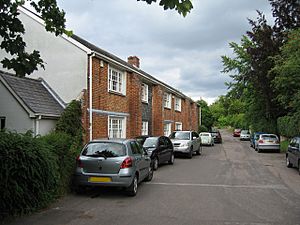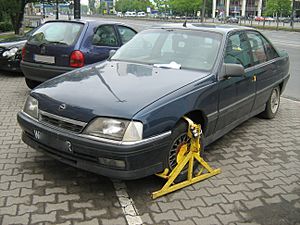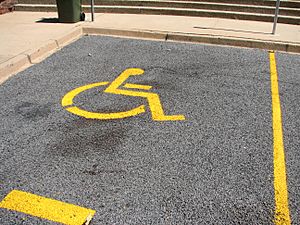Parking facts for kids
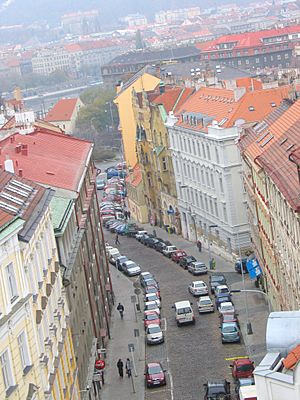
Parking a vehicle means stopping and leaving it somewhere. It is important to make sure that a vehicle is parked where it is allowed. If not, the driver might have to pay a fine, or their vehicle could even be clamped. Cars are usually parked in driveways, parking lots, garages, or on the side of the street.
Parking a car is usually easier than parking a large vehicle like a lorry (truck) or a coach. These bigger vehicles often need special parking areas. Parking rules are part of traffic laws, and they can be different in various countries. It is against the law to park on the sidewalk.
Contents
How to Park a Vehicle Safely
When you are driving on a road, you might see a space big enough to park your vehicle. To park correctly, especially using a method called "parallel parking," you should stop just past the space, next to the car in front. Then, slowly reverse (go backwards) into the space, aiming towards the curb. As you reverse, turn the steering wheel so you just miss the car in front. After that, you can adjust your car to leave equal space between the two cars.
If the parking space is wide enough for two cars, you can drive forwards into it instead of reversing. Parking well takes practice and experience. It is important not to hit the curb with your wheel, as this can damage your tire.
Where You Can Park
Parking on the Roadside
Vehicles can often be parked at the side of the road. They are usually parked parallel to the curb, which is the edge of the pavement or sidewalk. In some places, parking spots might be angled slightly (like 45 degrees) to the curb. Sometimes, there are no rules, and you can park there for free as long as you want.
In other areas, parking might not be allowed at all. For example, in Britain, double yellow lines mean no parking. Parking might also be allowed only for a short time. You cannot park on streets where construction is happening or on "snow routes" in winter, so snow plows can clear the road. Streets that need to be clear for emergency vehicles, like ambulances and fire trucks, also do not allow parking.
Drivers might have to pay to park. You can put Money into parking meters found next to each parking spot. Sometimes, there is a machine nearby where you pay and get a ticket. You must leave this ticket inside your car to show you have paid. The ticket will show the time and date you arrived.
Understanding Parking Fines and Towing
If a driver does not pay for parking or stays longer than allowed, they might get a parking ticket. This ticket is given by a traffic warden, a police officer, or a meter maid. These people check streets for illegally parked cars. If you get a ticket, you will have to pay a fine.
In some cities, cars might be clamped. This means a heavy clamp is attached to one of the wheels, so the car cannot be driven away. The driver then has to call a special company to unlock the clamp, which costs a lot of money.
In other places, the police might even take the car away. They use a crane to lift the car onto a lorry or a tow truck and take it to a special police parking lot. Getting your car back from there also costs a lot of money.
Parking Lots and Car Parks
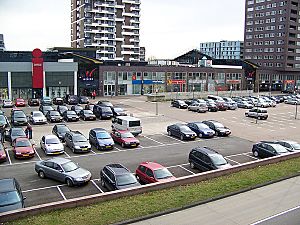
Car parks (or parking lots) are areas where you can park and leave your car. They can be very small or very large. They might be paved with asphalt or concrete, or they could be covered with gravel or just bare ground.
In cities, car parks are usually paved. Parking spots are marked with painted lines, and drivers are expected to park within these lines. Cars are usually parked side by side in these areas.
Sometimes, there is an attendant who collects a fee for parking or gives you a ticket with your arrival time. You pay the fee when you leave. Other times, you get a ticket from a machine at the entrance and pay an attendant at the exit.
It's important to know that some car parks can be unsafe, especially at night if they are not well-lit.

In rural areas, like at a country fair or concert, drivers might park in a field that has been mowed. Ropes or hay bales might guide drivers. An attendant usually helps direct cars. There might be a small fee, but often it's free. A "Park and Ride" is a large car park on the edge of a town. Drivers can park there and take a bus or tram into the town center instead of driving all the way in.
Another type of car park is an "attendant car park." Here, you leave your car keys with an attendant. They park your car very close to others to save space. This is common at airports. You tell the attendant when you expect to return.
Some car parks are private. They are only for people visiting the hotel, store, or firm that owns them. If you park there illegally, your vehicle might be clamped or towed.
On busy highways, there are areas just off the main road for parking, called layovers or rest areas. They sometimes have restrooms, vending machines for snacks, or even restaurants.
Parking for Disabled Drivers
Some car parks have special spaces reserved for disabled people. These spots are usually close to the exit or the front doors of a store, hotel, or restaurant. This makes it easier for disabled drivers or passengers to get in and out. These spaces are clearly marked and are usually wider than regular spots. This extra width allows vehicle doors to open fully for easy access.
It is very important for disabled drivers to display a valid disabled badge or sign in their vehicle. This shows that they are allowed to park there. Drivers who are not disabled should never park in these special spots, as they risk getting towed or fined.
Parking Garages
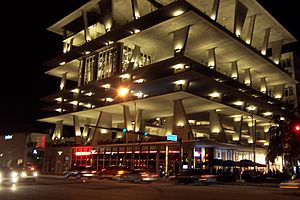
Parking garages (also called multi-level car parks) are buildings made of concrete and steel used for parking vehicles. Many are found in city centers where street parking is limited. Parking garages often have several levels connected by ramps. Some are open to the weather, meaning they can be cold or windy in winter. Sometimes, the ground floor of a parking garage has shops or cafes.
To use a parking garage, you drive in and take a ticket that shows your arrival time. You might drive up several ramps to find an empty parking space. When you leave, you pay the parking fee at the exit, and a barrier lifts so you can drive away.
Parking garages can sometimes be unsafe for drivers and passengers. They might be dimly lit, not have many staff, or not be watched closely. Hidden stairways and elevators (lifts) can be risky, especially if you are alone.
Parking garages are often found near office buildings, hospitals, universities, and other busy places where there isn't much land for parking. Some apartment buildings have their own parking garages for residents. Some buildings even have underground parking garages, which are usually only for residents, employees, or customers.
The Cost of Parking
Parking spaces in cities can be very expensive, especially where land prices are high. In busy city areas, finding parking can take a lot of time and often costs a lot of money. For example, in Boston in 2009, a single parking space was sold for $300,000!
Here are some examples of how much it cost for 2 hours of parking in some major cities in 2017:
| Country | City | Price (USD) |
| United States | New York | $32.97 |
| Australia | Sydney | $28.45 |
| Australia | Brisbane | $21.77 |
| Australia | Melbourne | $21.56 |
| United States | Boston | $20.80 |
| United States | Chicago | $18.66 |
| United Kingdom | London | $16.26 |
| Japan | Tokyo | $15.16 |
| United States | San Francisco | $14.85 |
| United States | Washington DC | $14.28 |
| United States | Philadelphia | $12.18 |
| China | Hong Kong | $11.74 |
| France | Paris | $11.32 |
| Japan | Osaka | $10.86 |
| United States | Detroit | $10.82 |
| Netherlands | Amsterdam | $10.57 |
| United States | Los Angeles | $10.13 |
| Canada | Montreal | $9.87 |
| United States | Miami | $9.77 |
| Japan | Yokohama | $9.73 |
| United States | San Diego | $9.42 |
| Canada | Calgary | $9.24 |
| Israel | Tel Aviv | $9.19 |
| United States | Denver | $8.88 |
| South Korea | Seoul | $8.71 |
Images for kids
-
A parking garage in Gloucester, England
-
Parking lot in New York City with capacity multiplied by stacking with lifts
-
An underground parking garage at the University of Minnesota
-
A station car park in Hamburg allows people to park and take the train into the centre.
-
Long-stay parking at Edinburgh Airport
-
A sign indicating that no parking is allowed on a lane


